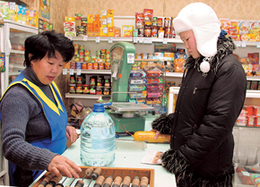 |
|
Chinese traders carry their luggage in a city in Heilungjang Province, China, which borders Russia.
|
Russia feels strong influence of its more populous neighbor
By Bertil Lintner, independent journalist The Chinese food is excellent at the Xianggang Restaurant. After dinner, people dance to the tunes of Hotel California in front of the bar. The place is popular-full every night-and "Xianggang" means, of course, "Hong Kong" in pinyin, the standard Romanization across the border in the Chinese province of Heilongjiang. For this is not a Chinese eatery in the West, but in Khabarovsk, in the Russian Far East. The Xianggang Restaurant is only one example of how Chinese influence is spreading in Russia's easternmost territories. Chinese merchants already dominate local trade and commerce, and many have settled not only in Khabarovsk but also in Blagoveshchensk, Vladivostok and Irkutsk, at the same time as the Russian population is declining. The birth rate is low, and every year thousands of Russians move to European Russia to look for jobs because factories are closing down and military installations have been withdrawn. Many local residents and government officials believe that 100 years from now, this region may no longer be part of Russia. Economically, the Russian Far East is already more or less separated from European Russia. Before the Soviet Union disintegrated in 1991, the Far East supplied European Russia and the other Western republics with fish and crabs from the Sea of Okhotsk. The area's heavy industry produced steel, aircraft and even ships, and few foreign consumer goods could be found in shops and markets.Today, Chinese consumer goods, cheaper and better than those produced far away in European Russia, are flooding the markets along with Chinese food, while timber and raw materials are going across the border to Heilongjiang. Entire factories are being dismantled and sold as scrap metal to China, and Chinese seafood is almost exclusively sold to South Korea and Japan. Given this climate, demographic changes are becoming evident. When communism essentially collapsed along with the Soviet Union, Chinese border traders and seasonal workers arrived in the Russian Far East. Here, it is still mainly a floating population that moves back and forth across the border, but now many are choosing to stay, as Vilya Gelbras, professor and China specialist at Moscow State University, pointed out at a seminar in Blagoveshchensk last year: "Now every second Chinese arrives in Russia with a firm intention not to go back to China. Most of them cannot be classified as 'free migrants' anymore." Many acquire false documents, even citizenship, from corrupt local officials, who are more willing to accept bribes from Chinese and other foreigners than from fellow Russians, who may complain to the authorities. Russia's Far Eastern Federal District is huge. Having always attracted settlers and adventurers, it was conquered by the Russians in the 19th century, and it became a dumping ground for criminals and political undesirables. But its population remained extremely sparse. "The District", as it is called, covers 6,215,900 square km, but contains only 7 million people, which is a figure down from 9 million in 1991. Across the border, China's three northeastern provinces-Heilongjiang, Jilin and Liaoning-are home to 100 million people, and the area has, even by Chinese standards, an unusually high unemployment rate. Or, as one Western analyst told me: "If the Russians continue to move out, the Chinese are ready to fill the resultant population vacuum in the area." That could lead to more than just a change of the demographic balance in what is still the Russian Far East, as political loyalties of the Chinese in the region will remain with China. Russia is too poor, backward and different for any Chinese migrant to easily find identity with.
 |
|
A shop in Khabarovsk, Russia, run by a Chinese migrant
|






